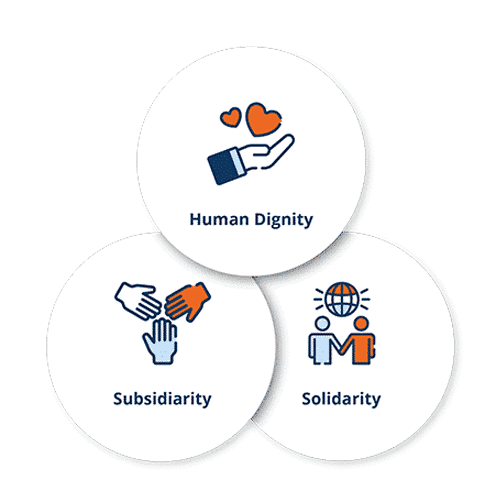58th F.C.E.M. World Congress
World Forum for Women Entrepreneurs
Women Nurturing Sustainable Development
Remarks by Anna Maria Tarantola
Deputy Director General of the Bank of Italy

Anna Maria’s Remarks at the 58th FCEM World Congress
Introduction by CAPP-USA: The US Federal Reserve published a paper in May 2022 where it analyzed a large corpus of global central bank speeches related to climate change and identified the “Most relevant speeches by year from 1997-2021” (Central Bank Communication about Climate Change).
The result of their analysis identifies the presentation of our Foundation’s president (then Deputy Director General of the Bank of Italy) Anna Maria Tarantola’s “Women Nurturing Sustainable Development” as the best delivered in 2010. And, as the title indicates, it is not only an excellent presentation on climate change, but it also focuses on the role of women.
Here are Anna Maria’s remarks:
I would like to thank the President of AIDDA, Laura Frati Gucci, for inviting me to the 58th FCEM World Congress in this conference entitled “How Women Face the New Economy and Ecology”. The goal of the conference, to assess women’s contribution in balancing economic growth and natural resource conservation, is both topical and challenging. This is not the first time I find myself considering human-ecosystem interaction: natural resources are a fundamental input for production and consumption; the environment is the receptacle for the waste generated by these processes. (Tarantola A.M. (2010), Crescita economica, benessere e sostenibilità della domanda di energia, remarks addressed to the Istituto Giuseppe Toniolo di Studi Superiori, Naples, 20 January). The fundamental question we must address today is how to increase and spread wealth and wellbeing while respecting and protecting the environment.
The role of women is central. Throughout history, women and nature have been closely linked: in Ayurvedic philosophy, prakriti – nature – is symbolized by a woman; similarly, the idea of “mother earth” is common to many Indo-European cultures. Perhaps it is no accident that so many of those who have contributed to raising our environmental consciousness have been – and are – women. Let me mention four of these outstanding women.
The biologist Rachel Carson was the first to study the harmful effects of DDT in the early nineteen-sixties. She can be considered the founder of the modern environmental movement. She was a scientist who stood behind her findings despite fierce attacks from the chemical industry lobby.
The environmental scientist Donella Meadows co-authored the book Limits to Growth (Meadows D.H., Randers J., Meadows D.L. and W.W. Behrens (1972), The Limits to growth: A report for the Club of Rome’s Project on the Predicament of Mankind) which laid the foundations for an analysis of the Earth’s limited capacity to support economic and demographic growth. This report was criticized – in particular by economists (Nordhaus W.D. (1992), Lethal Model 2: The Limits to Growth Revisited, Brookings Papers on Economic Activity, Economic Studies Program, The Brookings Institution, vol. 23) – but without doubt it had a profound impact on the analytical method used to study environmental problems. Meadows used computer technology to apply the theory of complex systems to the economic analysis of the reciprocal effects of growth and the environment; this is now the standard method to analyse the economic effects of climate change (Integrated Assessment Modelling).
The Nobel Peace Prize winner Wangari Maathai, an activist and founder of the environmental movement Green Belt, contributed importantly to the reforestation of vast areas of Kenya. Reforestation not only plays a primary role in combating desertification, ensuring that soil retains its nutrients and water resources, but it is also an essential tool for reducing greenhouse gases. About one-fifth of green house gas emissions are linked to deforestation. As a result, reforestation has become a means of reducing the concentration of climate-altering gases, and whose centrality is witnessed by the United Nations’ Program for Reducing Emissions from Deforestation and Forest Degradation (UN-REDD) – which aims to make it more economic to conserve and manage forest resources correctly than to deplete them.
Maathai demonstrated that managing common resources, such as the environment, does not necessarily have to lead to over-exploitation, to the “Tragedy of the Commons” as prophesied by Garrett Hardin. The economist Elinor Ostrom found evidence to support this outcome in her research on institutional economics. Ostrom was awarded the 2009 Nobel Prize in Economic Sciences, the first woman ever to win in this category, for her work on economic governance.
1. Women and the Environment in Developing Countries
In industrialized countries, women have made important contributions in raising our environmental consciousness. In developing countries, however, where rural communities are still prevalent, women remain in a condition of profound dependency on their surrounding environment; women are often responsible for activities essential for family subsistence: collecting water and firewood and working in the fields. (A review can be found in the volume published by UNEP (United Nations Environmental Program), 2004, Women and the Environment.)
For this reason, environmental degradation, and the effects of climate change on the availability of water resources and crop yields, particularly hurt women. Migration owing to climate change, (Tarantola A.M. (2009), Economia solidale e sviluppo sostenibile nell’era della post globalizzazione, remarks addressed to the Fondazione Sorella Natura, Rome, 26 June.) which primarily affects men, further increases the burden of toil for women. Moreover, women and children account for the majority of victims in environmental catastrophes, the frequency of which could increase in the future because of global warming. In the recent tragic flooding in Pakistan, 85 per cent of the victims were women and children. (Mandelbaum J., The female victims of Pakistan’s flood, Salon, 20 August 2010.)
It is emblematic that the Millennium Goals place side-by-side the objectives of gender equality and a development model for the sustainable use of natural resources.
Women are therefore the ideal interlocutors for the adoption and dissemination of sustainable practices and it is precisely because of their sensibility that Agenda 21 for the promotion of sustainable development recommends increasing “[…] the proportion of women decision makers, planners, technical advisers, managers and extension workers in environment and development fields”.
A prerequisite for increasing female participation is improving conditions overall for women. A World Bank study shows that in countries where women are better educated, there is greater success adapting to the negative effects of climate change (World Bank (2010), Adaptation to climate extremes in developing countries: the role of education). Indicators from the Global Gender Gap, referring in particular to economic participation and opportunity, on the one hand, and political empowerment on the other, show depressingly low figures for women in Sub-Sahara Africa, the Middle East, and North African countries (below 0.5 with reference to economic participation, 0.2 with reference to political empowerment) and reveal an enormous disparity with respect to men (World Economic Forum (2010), The Global Gender Gap Report 2010).
2. The Industrial World: A Green Economy Led by Women?
In industrialized countries, the availability of high quality forms of energy has greatly reduced the amount of time and effort that women must dedicate to housework. Women here no longer are required to interact directly, and on a daily basis, with the environment to meet family needs. Nonetheless, there is substantial evidence that women are more sensitive to environmental matters.
According to OECD research, the most environmentally-aware consumers are women. They are more likely than men to recycle domestic waste, buy organic food and green products, and place greater value on fuel-efficient means of transport (OECD, Survey on Household Environmental Behaviour, 2008).
These results are confirmed by other studies. A survey conducted by Eurobarometro found that in 2007 the share of women who said they had done something to improve the environment was six percentage points higher than for men; the International Social Survey Programme’s 1993 study of attitudes to the environment found, in the sample of countries surveyed, a large gap between women and men in terms of willingness to pay more for eco-friendly consumer goods, particularly in Italy, Australia and Norway. (The data can be consulted online at .) Recent behavioural studies give further support to these results (Czap N. and H.J. Czap (2010), An experimental investigation of revealed environmental concern, “Ecological Economics”, vol. 69.).
Can this greater willingness to consider the effects of one’s actions on the environment be integrated in the transformation process that is “greening” our economies? In brief, does the green economy represent an opportunity to capitalize on the strong bond between women and nature?
The answer is yes – but only if the necessary policies are implemented to ensure that this opportunity is realizable and we can reap the dual dividends of more sustainable, less discriminatory, economic growth. For this to happen, actions must be taken to increase women’s presence in the work force in general and in the green economy in particular.
The Lisbon agenda indicated the affirmative action that should be taken to prevent discrimination against women in their professional development. Among these, those making it easier for women to combine career and family are particularly important. For example, a study of the development of the photovoltaic sector in Southern Italy underlines the fact that despite very high female employment potential (among recent architecture graduates, women outnumber men), the realization of this potential could be blocked by the lack of pre-school facilities for young children. (Barboni A. (2009), Women Workers in the Photovoltaics Industry in Southern Italy, a study prepared for the previously cited Sustainlabour report.)
Other measures relate specifically to the possibilities offered by the new green sectors with the greatest growth potential (renewable energy, construction techniques, and agricultural biomass).
In these sectors, women represent a very small part of the total work force and they rarely hold the top positions. (A joint UNEP-Sustainlabour study estimates that fewer than 1 per cent of top managers in the energy industry are women. Sustainlabour (2009), Green Jobs and Women Workers, Draft Report.) This is due primarily to cultural factors, which have perpetuated a high level of segregation in these industries. Even in traditional energy sectors, female participation is extremely low – 14 per cent according to the latest survey of firms.
In the future, the fact that only a small number of women pursue advanced degrees in the sciences could penalise their access to the green economy. In Italy, only 17 per cent of women under the age of 44 have taken a scientific degree course at university (compared with 39 per cent of men); almost twice as many study the humanities. It is essential to launch a comprehensive information campaign to guide women’s choices towards the subjects that have the greatest employment potential, breaking the vicious cycle of segregation in the traditional energy sectors.
Women must have the opportunity to play a leading role in developing the green economy. It would be ironic indeed if the growth achieved with the development of the green economy actually increased the employment gap between men and women.
3. Conclusion
Women have a unique and strong bond with nature. This can and must be used as a stepping stone to design policies for sustainable development. We must aim to reconcile economic welfare, the conservation of natural resources, and environmental quality. We cannot afford to lose this opportunity to paint the green economy pink.
To achieve these goals, however, women must be enabled to provide their contribution. The weight of women in politics, in institutions and throughout the business world must be increased, including at the top levels. For this to happen, a joint effort is required by all stakeholders – politicians, firms, trade unions, civil and cultural leaders, the media – and women themselves. A more efficient use of female resources in the labour market and a higher presence of female entrepreneurs can help us to pursue a more sustainable and more equitable economy, more attentive to the needs of the environment and of human beings themselves.
In less developed countries, policies aimed to ensure women greater freedom of action (such as access to education and the right to vote) (Amartya Sen sees this extension of freedom, and not just greater physical wellbeing as the key to overcoming women’s subordination in the less developed countries. The same conclusions can be extended to the socially excluded in the developed countries. Sen A. (2001), Development as Freedom, O.U.P., 1999.) can help contrast the adverse impact of climate change, for example through mitigating measures (such as reforestation) and enabling ecosystems to be more resilient to higher temperatures (for instance, through the management of land and water resources to prevent desertification).
In industrialized countries, women’s greater eco-awareness places them in an ideal position to actively participate in setting policies that can attenuate the utilization of natural resources and limit the harmful effects of consumption and production on the environment. The presence of a greater number of women entrepreneurs in innovative sectors, such as the green economy, is also key to achieve these goals.
Even simple actions can help to reduce our impact on the ecosystem: conservation of resources (by water and energy saving) and pollution control (for example, more eco-friendly means of transport and producing less household waste). The literal meaning of economics is “household management” and women have traditionally been the frugal, pragmatic, responsible and farsighted managers of home and family. The same can be true for the environment – home to us all.
Almost twenty years ago, the Rio Declaration proclaimed that “Women have a vital role in environmental management and development. Their full participation is therefore essential to achieve sustainable development”. Now is the time to translate this declaration into action to ensure a better, fairer and more sustainable future, for all of us and for generations to come.





